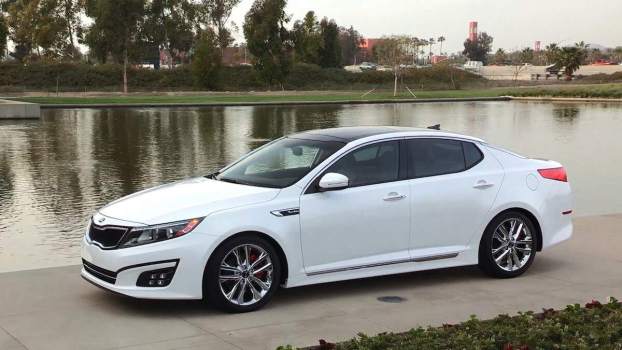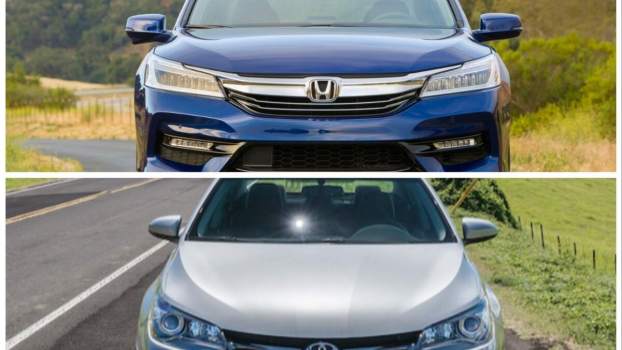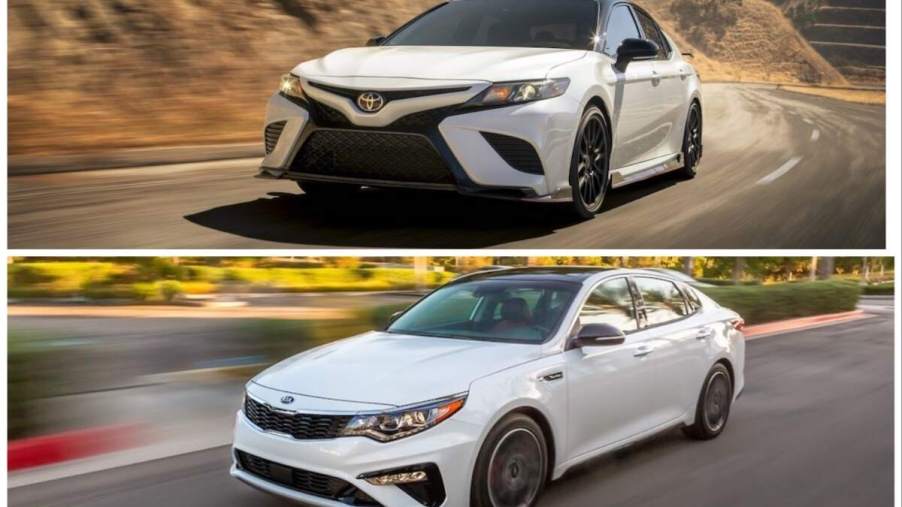
Is the 2020 Toyota Camry or the 2020 Kia Optima the Better Used Midsize Sedan?
The 2020 Toyota Camry and the 2020 Kia Optima are strong contenders among used midsize sedans. They attract shoppers looking for a balanced blend of style, substance, and affordability. This side-by-side comparison will help you decide which used car better fits your tastes and needs.
| 2020 Toyota Camry | 2020 Kia Optima | |
| Average Used Price | $24,500 | $23,400 |
| Base Engine | 2.5-liter inline 4-cylinder | 2.4-liter inline 4-cylinder |
| Horsepower + Torque | 203 hp @ 6,600 rpm + 184 lb-ft @ 5,000 rpm | 185 hp @ 6,000 rpm + 178 lb-ft @ 4,000 rpm |
| Transmission + Drivetrain | 8-speed automatic, front-wheel drive | 6-speed automatic, front-wheel drive |
| Acceleration + Top Speed | 5.8 seconds (0–60 mph) + 135 mph | 6.85 seconds (0–60 mph) + 130 mph |
| Fuel efficiency | 29/41 mpg city/highway | 25/32 mpg city/highway |
| Safety Rating | 5 stars (NHTSA) | 5 stars (NHTSA) |
2020 Toyota Camry pros and cons
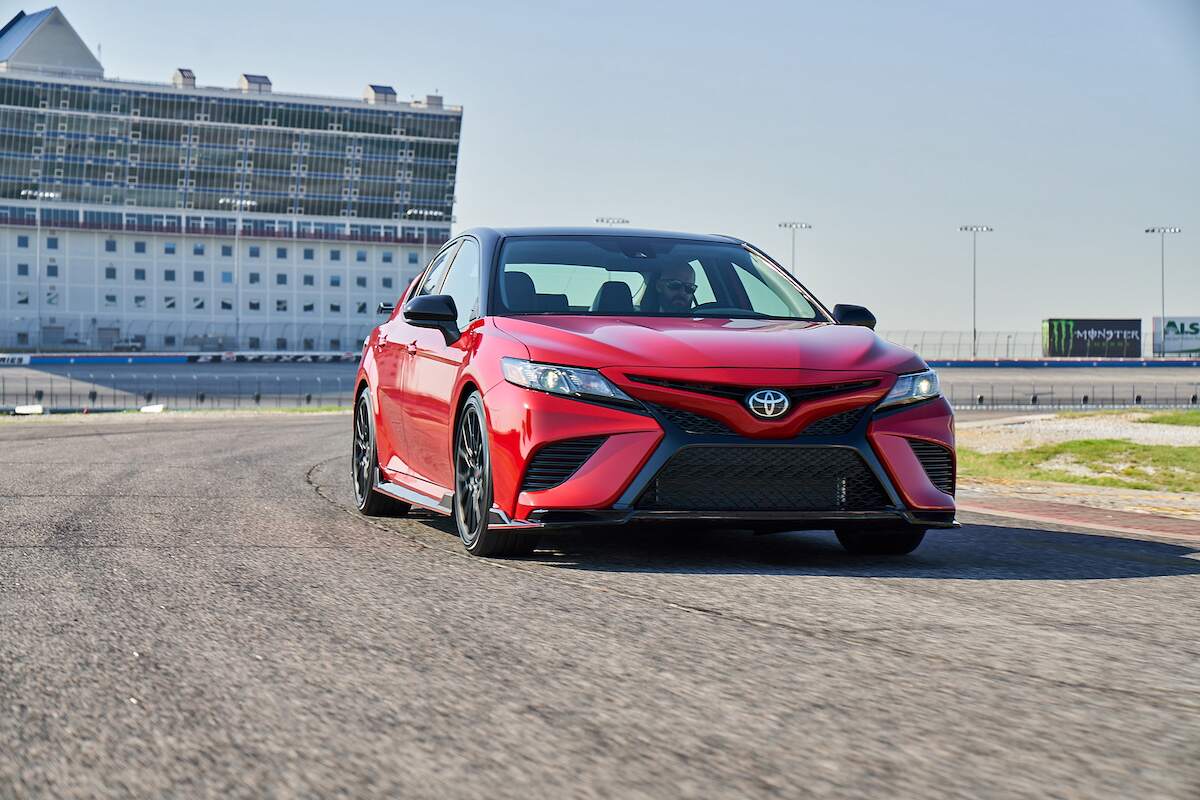
The Toyota Camry, a cornerstone in the midsize sedan segment, combines style, reliability, and a range of powertrains to suit various preferences. Its sleek exterior design exudes sophistication, while the interior emphasizes comfort and user-friendly technology. The 2020 Camry offered a lineup of engines, including an efficient 2.5-liter four-cylinder and a potent 3.5-liter V6.
The hybrid variant is an excellent option for eco-conscious drivers. And Toyota Safety Sense, standard on all 2020 Camry models, provides a comprehensive suite of advanced safety features.
Pros:
- Wide range of engine options, including a fuel-efficient hybrid.
- Comfortable and well-designed interior with user-friendly tech.
- Strong reputation for reliability and resale value.
- A comprehensive suite of standard safety features.
- Handles well and is comfortable to drive.
Cons:
- The base engine’s performance might not be as spirited as some rivals.
- Limited availability of all-wheel drive.
- Some interior materials could be of higher quality.
- Some engine and road noise enters the cabin.
- The trunk is somewhat small for the class.
2020 Kia Optima pros and cons
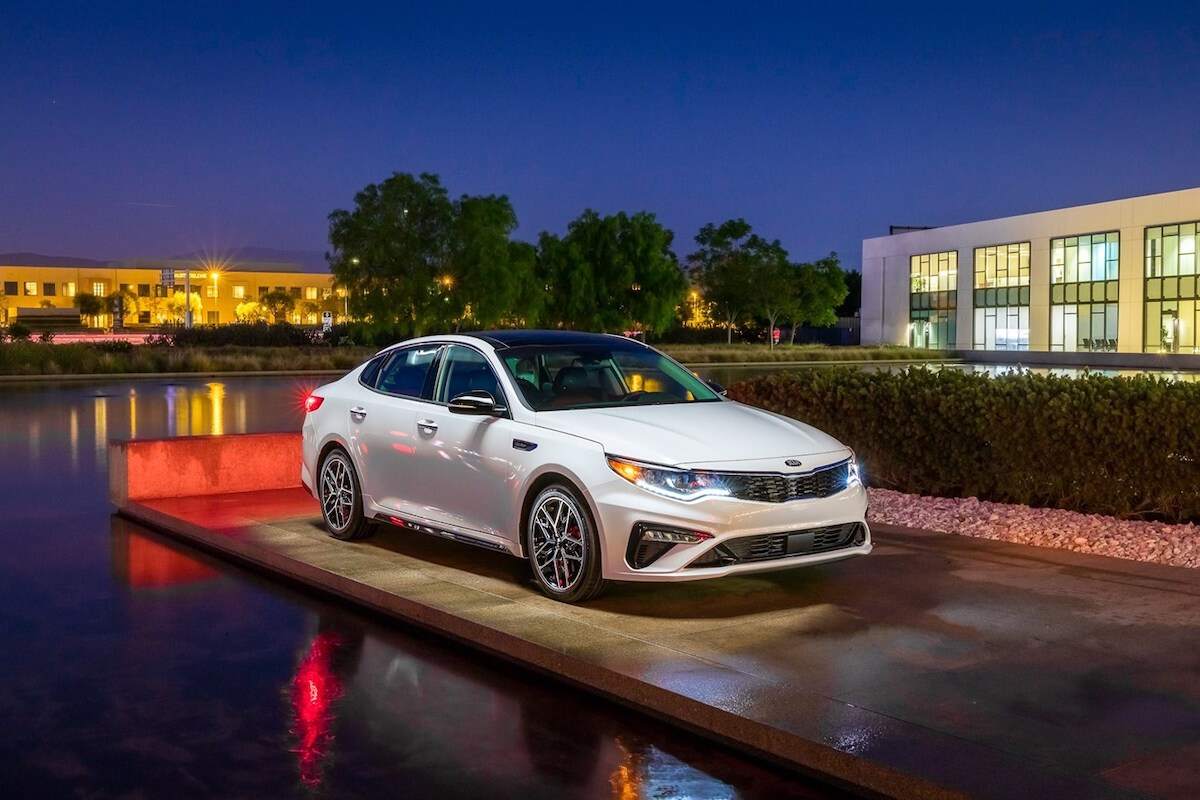
The 2020 Kia Optima stands out with its captivating exterior styling, offering a blend of performance and practicality. With an array of engine choices, including a turbocharged option and a fuel-efficient hybrid, the Optima caters to diverse driving preferences.
The interior boasts user-friendly technology and comfortable seating, and Kia’s reputation for value and warranty coverage remains an advantage.
Pros:
- Striking exterior design sets it apart in the segment.
- Range of engine options, including a powerful turbocharged variant.
- Generous warranty coverage and good value for the features offered.
- Available hybrid model for eco-conscious consumers.
- The interior is good quality and roomy.
- Features a large trunk.
- Handles well and provides a gentle ride.
- Intuitive infotainment system.
Cons:
- The base engine’s fuel economy is lower than some competitors.
- Ride quality could be firmer than expected for some occupants.
- Less agility than competitors in the same class.
- Interior materials could be improved compared with rivals.
- The base engine model is a little below average.
2020 Toyota Camry vs. 2020 Kia Optima: Driving and performance
The 2020 Toyota Camry and 2020 Kia Optima offer engaging performance. The Camry boasts a well-rounded driving experience with smooth handling, precise steering, and a comfortable ride. Its range of engine options provides varying levels of power and efficiency to cater to different preferences.
The 2020 Optima also delivers a commendable driving performance. It features a responsive suspension system that balances comfort and agility. The available turbocharged engine offers peppy acceleration, making it an enjoyable option for shoppers seeking a more spirited drive.
Overall, the Camry and Optima bring their strengths to the table in terms of driving and performance. The choice between the two largely depends on personal preferences for driving dynamics, power, and handling.
2020 Toyota Camry vs. 2020 Kia Optima: Interior and tech
As for the interior and tech, the 2020 Toyota Camry and 2020 Kia Optima present unique offerings.
The Camry’s cabin boasts an ergonomic layout and high-quality materials, creating an inviting atmosphere. Its infotainment system centers around a user-friendly touchscreen interface with smartphone integration, enhancing connectivity.
The Optima boasts a modern interior design, featuring intuitive controls and soft-touch surfaces. Its infotainment system, while also featuring smartphone compatibility, stands out with a larger screen and crisp graphics.
In the end, the Camry prioritizes a sleek yet functional design, while the Optima focuses on a contemporary and spacious cabin. Your preference boils down to whether you lean toward the Camry’s refined simplicity or the Optima’s bold and tech-forward approach.
2020 Toyota Camry vs. 2020 Kia Optima: Trim levels and features
Let’s dive into a more detailed breakdown of the two used midsize sedans’ trim levels and notable features.
2020 Toyota Camry trim levels and features
Camry L
- Engine: 2.5-liter Dynamic Force four-cylinder
- Transmission: Eight-speed automatic
- Key Features: Toyota Safety Sense P (adaptive cruise control, pre-collision system), Apple CarPlay and Android Auto compatibility, 7.0-inch touchscreen
Camry LE
- Engine: 2.5-liter Dynamic Force four-cylinder
- Transmission: Eight-speed automatic
- Additional Features: 17-inch alloy wheels, power driver’s seat, 60/40 split-folding rear seat
Camry XLE
- Engine: 2.5-liter Dynamic Force four-cylinder
- Transmission: Eight-speed automatic
- Additional Features: Leather-trimmed seats, 8.0-inch touchscreen, dual-zone automatic climate control, blind-spot monitoring
Camry SE
- Engine: 2.5-liter Dynamic Force four-cylinder
- Transmission: Eight-speed automatic
- Additional Features: Sport-tuned suspension, unique exterior styling, paddle shifters, available 301-hp V6
Camry XSE
- Engine: 3.5-liter V6
- Transmission: Eight-speed automatic
- Additional Features: LED headlights, 19-inch alloy wheels, panoramic sunroof, upgraded infotainment system.
2020 Kia Optima trim levels and features
Optima LX
- Engine: 2.4-liter four-cylinder
- Transmission: Six-speed automatic
- Key Features: 8.0-inch touchscreen, Apple CarPlay and Android Auto integration, Kia Drive Wise (forward collision warning, driver attention warning)
Optima S
- Engine: 2.4-liter four-cylinder
- Transmission: Six-speed automatic
- Additional Features: Sport front bumper, 18-inch alloy wheels, smart key with push-button start
Optima EX
- Engine: 1.6-liter turbocharged four-cylinder
- Transmission: Seven-speed dual-clutch automatic
- Additional Features: Leather upholstery, heated and ventilated front seats, wireless charging
Optima SX
- Engine: 2.0-liter turbocharged four-cylinder
- Transmission: Six-speed automatic
- Additional Features: Sport-tuned suspension, 18-inch wheels, panoramic sunroof, Harman Kardon premium audio system
Optima Hybrid
- Engine: 2.0-liter four-cylinder + electric motor
- Transmission: Six-speed automatic
- Key Features: Hybrid powertrain, EPA-estimated 42 mpg combined, advanced driver assistance systems
Which used midsize sedan is the right fit for you?
Ultimately, the decision between the 2020 Toyota Camry and the 2020 Kia Optima hinges on your individual preferences and priorities.
If you value a well-rounded package with a reputation for reliability, the Camry’s range of engine options and standard safety features might be your calling.
If striking design, a variety of engines including a potent turbocharged variant, and strong warranty coverage resonate with you, the Optima could be your ideal choice.
Either way, both models are affordable, high-quality used cars. With U.S. News scoring them nearly the same, the final decision boils down to your needs and desires.
